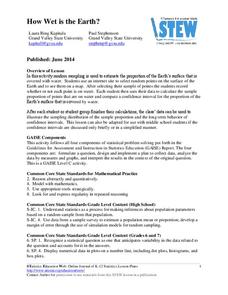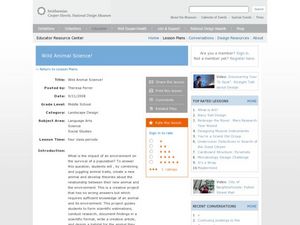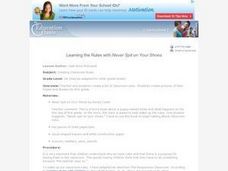Curated OER
Antonyms 5: Level 11
Repudiate abstruse worksheets! Rather than a perfunctory examination of antonyms, the ten prompts, and the meticulous attention to detail found in the answer key provided by this resource, will provide to be salubrious.
Curated OER
Mississippi Trial, 1955: K-W-H-L Strategy
To prepare for a reading of Christopher E. Crowe's Mississippi Trial, 1955, class members create a KWHL chart and begin by generating questions they have about the civil rights movement, slavery, and the death of Emmett Till.
Curated OER
Twelfth Night: The K-W-H-L Strategy
Readers of Twelfth Night use a KWHL chart to record information about what they know about Shakespeare's play, what they want to find out, how they plan on finding this information, and what they have learned or still want to learn about...
California Academy of Science
Snakes and Lizards Length and Movement
Snakes and lizards can be very tiny or very long. Your class will get out their rulers to see just how big snakes and lizards can be. They discuss several different reptiles by reading the included animal fact cards, then each small...
Teacher Printables
My Report Pack for. . .
Here is a handy guide for putting together a research report on birds, or on a selection of other topics (see the added materials.). Individuals are guided to think of three questions about their topic, they narrow down subtopics, use a...
Busch Gardens
Create an Invertebrate
What better way for young biologists to learn about invertebrates than by creating their very own? Here, students are assigned a set of invertebrate characteristics and are asked to invent an imaginary ocean animal and a separate...
Statistics Education Web
How Wet is the Earth?
Water, water, everywhere? Each pupil first uses an Internet program to select 50 random points on Earth to determine the proportion of its surface covered with water. The class then combines data to determine a more accurate estimate.
Nosapo
Body Language
When it comes to learning a language and literacy, understanding nonverbal communication is often as important as verbal communication. An interactive body language activity incorporates role play to demonstrate the difference between...
Transforming Education
Self-Management Strategies
What self-management techniques help scholars achieve their goals? Readers review a list of strategies for managing stress, increasing motivation, and setting goals. They discover how to monitor their emotions, create checklists to stay...
Missouri Department of Elementary
My Feelings
Encourage self-awareness with a lesson that challenges scholars to identify feelings—happy, sad, mad, and scared. Using a feelings thermometer, similar to that of a bar graph, pupils discuss how they would feel in specific scenarios then...
Missouri Department of Elementary
What are Comfortable (Good) and Uncomfortable (Bad) Feelings?
Two puppets open a discussion about comfrotable and uncomfortable touches. Scholars add to the discussion information they remember from a previous lesson, then delve deep into three problem-solving safety rules, and explore...
Transforming Education
SEL for Educators Toolkit
Four resources make up the SEL toolkit for educators. Intended for those that teach kindergarten to twelfth grade, helpful files include a companion guide, presentation, reference list, and a one-page snapshot that neatly showcases the...
Curated OER
Using Description to Write in Science
Fifth graders use science process and thinking skills. They communicate effectively using science language and reasoning.
Curated OER
Wild Animal Science
Students discover how environmental factors impact the survival of a population. In this landscape design lesson, students create a new animal and discuss the relationship between the animal and its environment before creating a habitat...
Curated OER
Ecology 8 Land Biomes
High schoolers identify and describe the main features of one land biome. After researching what a biome is, they give various examples of biomes around the world and in their backyards.
Curated OER
Weatherman Phil
Third graders examine the life of a groundhog and their role in predicting weather. They write a postcard or a letter to Punxsutawney Phil on the Internet.
Curated OER
Radical Reptiles
In this reptiles worksheet, students read about reptiles and then answer 10 questions about what they just learned. The answers are on the last page.
Curated OER
Bully Prevention
Young scholars examine the topic of bully prevention. In this character education lesson, students establish what bullying is, role play bullying scenarios, and discuss how to manage bullying incidents.
Curated OER
Human Impacts on Major Rivers of the World
Middle schoolers explore motivations behind human intervention in the stream flow of selected rivers, infer kinds of interventions and their results, and evaluate level of success of such interventions of stream flow as well as...
Curated OER
Field Guide to Schoolyard Insects and Their Relatives
Your entire class works together to create an illustrated insect field guide. The intent is that they venture outside of the classroom, find a critter, and then research it using reference materials, insect books, and the Internet for...
Curated OER
Diversity Discussion Questions
Have a class discussion on diversity. With your class, explore the ideas of prejudice, fear, suspicion and individual rights. Discuss the benefits of uniqueness and how diversity contributes to strength and unity.
Curated OER
What can I do?
Pupils identify feelings and explore positive ways to handle conflict. In this mental health lesson students discuss feelings and how to constructively handle them.
Curated OER
Out of the Dust: Questioning Strategies
Bloom's Taxonomy is a great way to address the many levels of comprehension. With explanations and examples of each level, you can create questions that focus on knowledge, comprehension, application, analysis, synthesis, and evaluation.
Curated OER
Learning the Rules with "Never Spit on Your Shoes"
Foster a sense of community by having youngsters work together to create a list of classroom rules. They draw pictures of their hopes for first grade after reading a children's book as a group. They also discuss why it is important to...

























